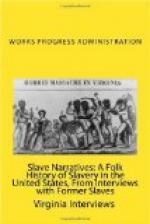“When my Missis took me away from the river bottom I lived in Poolesville where the Kohlhoss home and garage is. I worked around the house and garden. I remember when the Yankee and Confederate soldiers both came to Poolesville. Capn Sam White (son of the doctor) he join the Confederate in Virginia. He come home and say he goin to take me along back with him for to serve him. But the Yankees came and he left very sudden and leave me behind. I was glad I didn’t have to go with him. I saw all that fightin around Poolesville. I used to like to watch em fightin. I saw a Yankee soldier shoot a Confederate and kill him. He raised his gun twice to shoot but he kept dodgin around the house an he didn’ want to shoot when he might hit someone else. When he ran from the house he shot him.
“Yes sah, them Confederates done more things around here than the Yankees did. I remember once during the war they came to town. It was Sunday morning an I was sittin in the gallery of the ole brick Methodist church. One of them came to de door and he pointed his pistol right at that preacher’s head. The gallery had an outside stairs then. I ran to de door to go down de stairs but there was another un there pointing his gun and they say don’t nobody leave dis building. The others they was a cleanin up all the hosses and wagons round the church. The one who was guarding de stairs, he kept a lookin to see if dey was done cleaning up de hosses, and when he wasn’t watching I slip half way down de stairs, an when he turn his back I jump down and run. When he looks he jus laugh.
“My father he lived to be eighty nine. He died right here in this house and he’s buried over by the church. His name was Sam. They called my mother Willie Ann. She died when I was small. I had three brothers and one sister. My father married again and had seven or eight other children.
“I’ve had eleven children; five livin, six dead. I’ve been preaching for forty years and I have seen many souls saved. I don’t preach regular anymore but once in a while I do. I have preached in all these little churches around here. I preached six years at Sugar Loaf Mountain. The presidin elder he wants me to go there. The man that had left there jus tore that church up. I went up there one Sunday and I didn’t see anything that I could do. I think I’m not able for this. I said they needs a more experienced preacher than me. But the presidin elder keeps after me to go there and I says, well, I go for one year. Next thing it was the same thing. I stays on another year and so on for six years. When I left there that church was in pretty good shape.
“I think preaching the gospel is the greatest work in the world. But folks don’t seem to take the interest in church that they used to.”
Maryland
Sept. 30, 1937
Rogers
George Jones, Ex-slave.
Reference: Personal interview with George Jones,
Ex-slave,
at
African M.E. Home, 207 Aisquith St., Baltimore.




